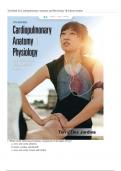Exam (elaborations)
Test Bank for Cardiopulmonary Anatomy and Physiology 7th Edition Jardins
- Course
- Nursing (NURS220)
- Institution
- Howard University
1. Which of the following are primary components of the upper airway? a. nose, oral cavity, pharynx b. larynx, trachea, and bronchi c. nose, oral cavity, larynx and trachea d. nose, oral cavity, pharynx, larynx, and trachea ANSWER: a FEEDBACK: a. The nose, oral cavity, and ...
[Show more]



